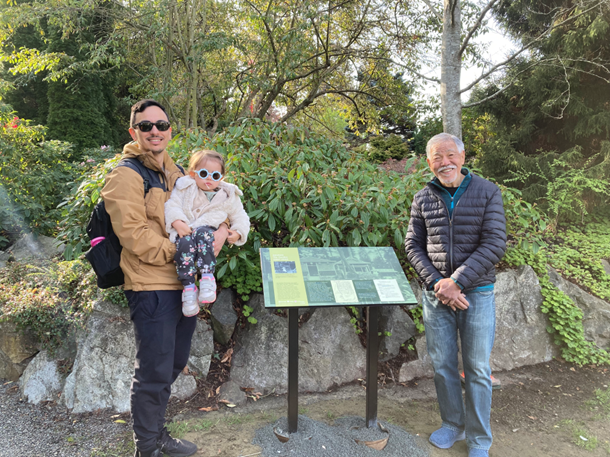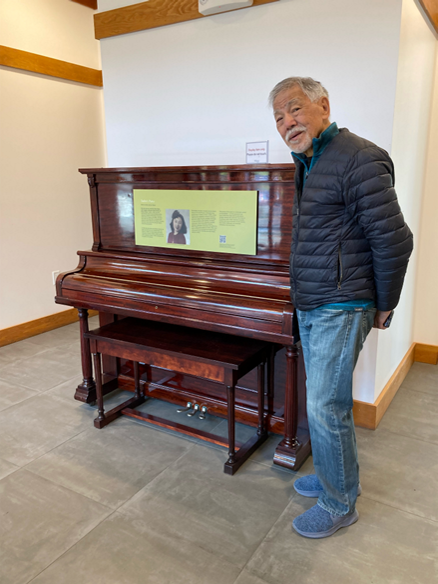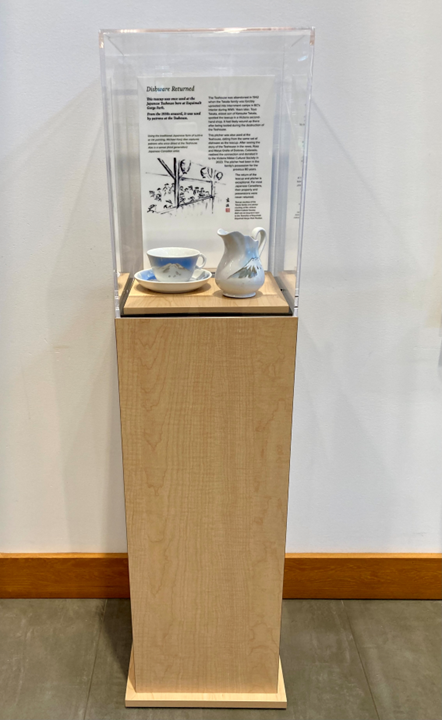Meet our Partners – Victoria Nikkei Cultural Society

Tsugio Kurushima, right, with Dillon Takata and daughter at the recently unveiled garden interpretive panels at the Gorge Park Pavilion.
As Tsugio Kurushima, President of the Victoria Nikkei Cultural Society, explains, “the Victoria Nikkei Cultural Society, or VNCS, is a Japanese cultural organization. We were formed in 1993 to provide and help create community for people of Japanese heritage or people interested in Japanese culture.”
“Our main focus has been on celebrating, sharing and promoting Japanese and Japanese-Canadian culture. So we run a lot of events for members, and we have events that are open to the public that demonstrate aspects of Japanese culture. More recently we have been getting involved in advocacy-type activities, such as lobbying against issues, but we’re still primarily focused on promoting and sharing Japanese culture—with the greater community, but also for our members.”
The Victoria Nikkei Cultural Society began working with Past Wrongs, Future Choices through an earlier partnership with its predecessor Landscapes of Injustice.
“There was an initiative to build a teahouse in Esquimalt Gorge Park, because from 1907 to 1942 there was the Japanese Teahouse and Garden, and other attractions. It was quite a popular place for Greater Victoria citizens to come to and enjoy. That all ended when Japanese Canadians were interned in 1942. They were dispossessed of their belongings, they were dispersed, and they didn’t return to the West Coast because many of them had nothing to return to. So we thought it would be fitting for the Township of Esquimalt to use some of that money [available for waterfront projects at the time] to recognize and honour the contributions of the Japanese Canadian community in the local community. I approached Jordan Stanger-Ross to see if Landscapes of Injustice would assist us in that campaign and they wholeheartedly embraced us and we formed a partnership. Long story short, […] our ask evolved to a general purpose facility that would have Japanese design elements to honour the presence of Japanese Canadians in that area before the war. And what resulted is the Esquimalt Gorge Park Pavilion—it’s quite an attractive building and also a popular facility that has drawn attention to Gorge Park.”
Tsugio explains that this project, the building of the Gorge Park Pavilion, made up the first phase of the three-phase project being led by the Victoria Nikkei Cultural Society (VNCS). These projects are taking up the task of honouring a landmark and history erased by the legacy of internment and dispossession in what is now Esquimalt’s Gorge Park.

The second phase reached an exciting milestone in April 2024 with the installation and unveiling of new interpretive panels at the Gorge Park Pavilion, in partnership with Past Wrongs, Future Choices and the Township of Esquimalt. As Tsugio explains, the major driving forces of this project were Andrea Mariko Grant who curated the panels, Sue Donaldson who oversaw the production, and the installation done by Esquimalt park staff, while Tsugio’s contribution focused on securing the Township of Esquimalt’s support. From 2022 to 2024, they worked on aspects ranging from funding to curation to physical installation to making “numerous” presentations to council to promote the importance of building local community through initiatives centering public history and education.
The unveiling of the two new interpretive panels at the Gorge Park Pavilion honours Japanese Canadian history in Victoria, BC, as panel curator Andrea Mariko Grant explains. As Tsugio tells me, “one of the panels is about the Japanese garden when it was in its heyday, and the other is about Isaburo Kishida who was the Japanese gardener that designed the garden, who also designed the Japanese gardens at Royal Roads and Butchart Gardens. He was the father of one of the co-owners of the Japanese Teahouse and Garden. It was a joint ownership between the Takata family and the Kishida family.”
Apart from the two panels, they also installed a display of an original teacup, saucer and milk pitcher that were used in the Japanese Teahouse and Garden when it was operating—pieces which all come with their own interesting stories of finding their way back to the original Teahouse site.

The work on the three-phase project, and the VNCS broadly, is volunteer-driven. As Tsugio also notes, the work of the VNCS is supported through its strong relationship and friendships with the Township of Esquimalt, as well as Past Wrongs, Future Choices. “Landscapes of Injustice and Past Wrongs, Future Choices, they have a lot of expertise and knowledge of the internment, but they also help support these campaigns in many ways.”
“It’s been great, they’ve been a very supportive and helpful partnership in all that we’ve done. The outcome of Landscapes of Injustice has been a valuable resource for all members of the Nikkei community across Canada, and for locals. For people to be able to research their family history and documents, it’s been for some people very revealing and emotional. Past Wrongs, Future Choices, it just shows the breadth of Japanese diaspora […] so with Past Wrongs, Future Choices it’s very informative to learn about the other communities and what they went through during World War II.”
When it comes to what the new interpretive panels are doing, as Tsugio puts it, “they’re educating the public. […] A lot of people in the public didn’t even know the internment took place. So the interpretive panels in the pavilion and in the garden, they’re educating the public—and recognizing the contribution that these early Japanese Canadians made to the local region and to Canada. So that’s a very important aspect of why I do this. The other is for the Japanese Canadian population. There is an education element to it, but there is also a reclamation of our past history.”
The VNCS will continue into Phase 3 of their project—a public art piece—as they continue to provide programs to support members, and find opportunities to educate and celebrate the culture and contributions of the local Japanese Canadian community.
“We are the keepers and promoters of Japanese culture, of our Nikkei community here in the Greater Victoria community. […] What we have been able to do is build community, and that was one of the main purposes of our society, to be a focal point and to build community for people of Japanese heritage—and I think we are succeeding.”
This article was written by Sarah Stilwell, from an interview with Victoria Nikkei Cultural Society President Tsugio Kurushima in June 2024. All photos are courtesy of Sue Donaldson.

 Instagram
Instagram